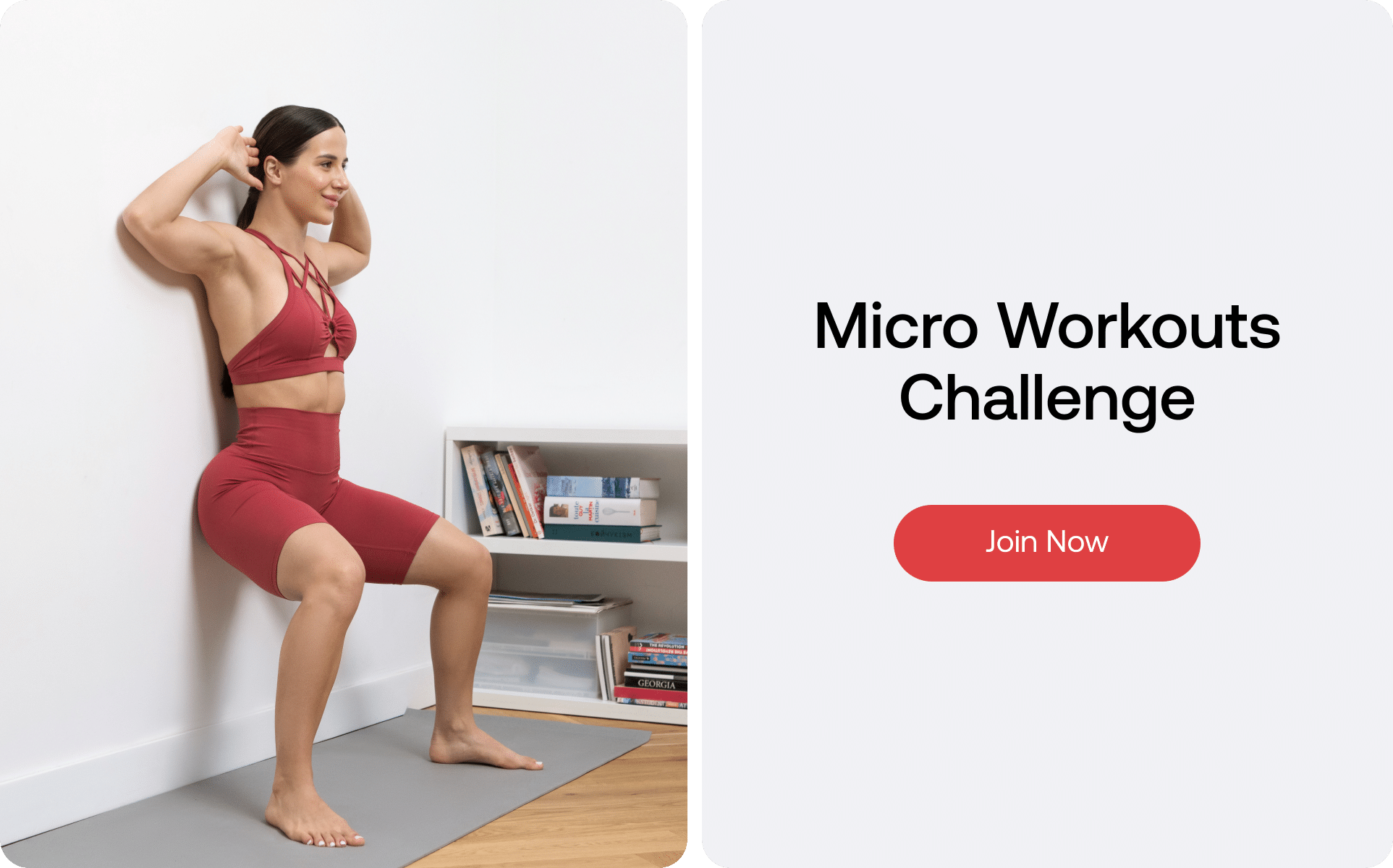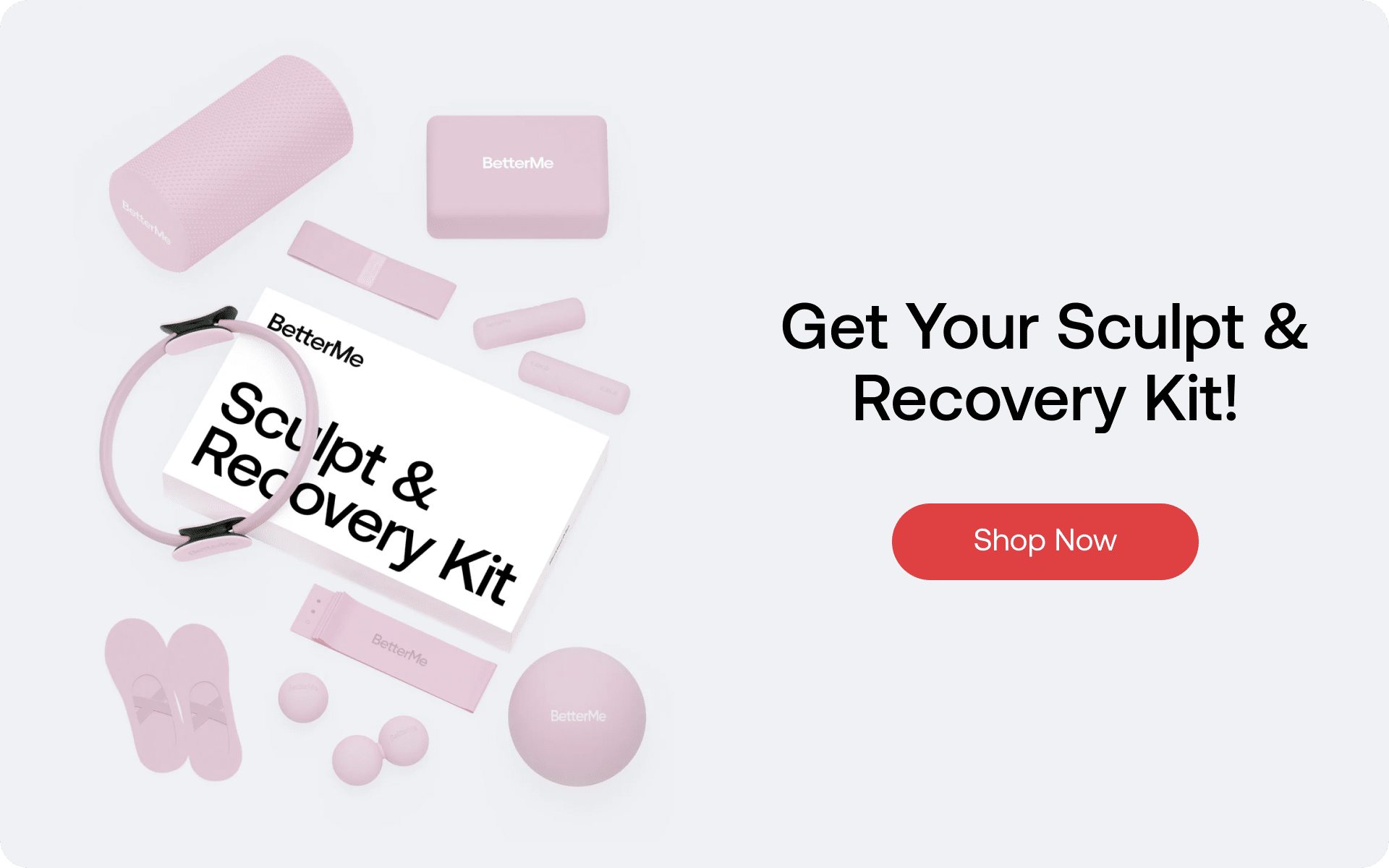The speed at which you’ll achieve your fitness goals will be determined by how easy it is for you to work out consistently.
Sure, you can drag yourself to the gym every day for several weeks, but after some time life’s demands will creep in and you’ll need to look for a more flexible alternative.
Having portable fitness tools like mini resistance bands can be a game-changer. Knowing exercises that you can do literally anywhere—from your living room to a hotel room—will give you that edge to make sure your workout doesn’t end up on the back burner.
Here’s a guide to getting started with mini resistance band exercises that are simple, yet effective. These are achievable, no-nonsense movements designed to stretch, strengthen, and sculpt your muscles.

What Are Mini Bands for Strength Training?
Mini resistance bands, also known as mini loop bands or glute bands, are elastic exercise tools that come in a variety of resistance levels. They can be used for both upper and lower body workouts and are designed to activate your muscles by providing external resistance during movements.
These flexible loops are made from either latex or fabric and typically have a circumference of 12 inches. You can wrap them around your ankles, thighs, or arms to add resistance to bodyweight exercises or traditional strength training movements.
In our previous post; Beginner Workout for Lower Butt, we discussed a number of exercises that target the lower glute muscles, to help you achieve a toned, lifted butt. Mini bands may look small and unassuming, but don’t let that fool you – they pack a punch when it comes to your fitness routine.
BetterMe is your fast-track ticket to a long-lasting weight loss! Tailor your fitness journey and maximize your results with just a couple of swipes!
What Is The Difference Between Resistance Bands and Mini Bands?
The difference between resistance bands and mini bands is primarily their size. Resistance bands are longer and may either be looped or have handles. Mini bands, on the other hand, are smaller and more compact in size. They are always looped.
While resistance bands are typically used for full-body workouts and stretching exercises, mini bands are primarily used for activating muscles and adding resistance to specific body parts.
Another difference between these two types of exercise bands is their range of resistance levels. Resistance bands usually come in a wider variety of resistances, while mini bands typically have 3 to 5 levels of resistance.
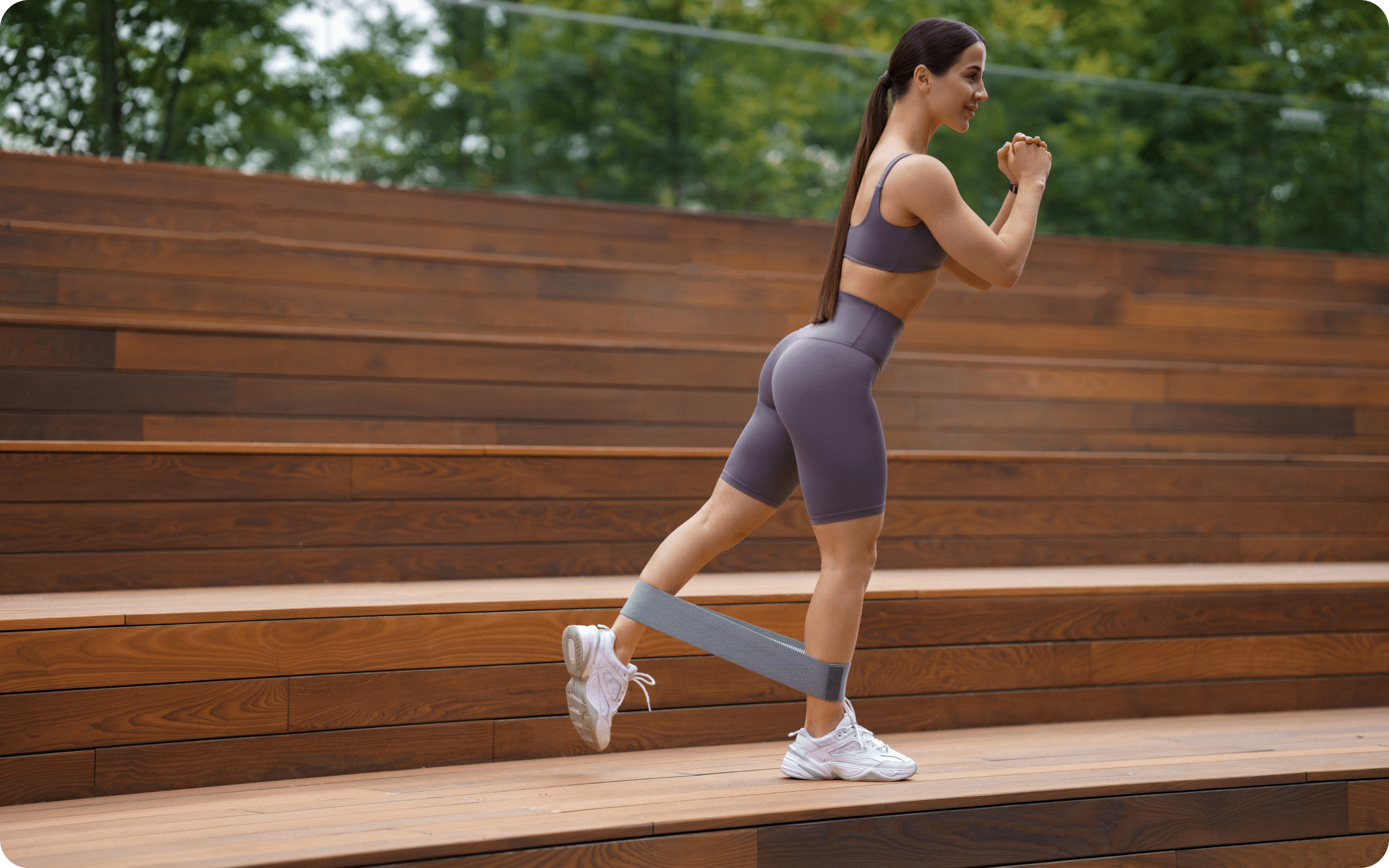
Can Mini Resistance Bands Build Muscle?
A mini resistance band workout can help you build muscle because they provide resistance to your muscles during exercises (2).
When you use a mini resistance band, it places tension on your muscles, causing them to contract and work harder. This breaks down the muscle tissue, which then repairs and grows stronger with proper nutrition and rest.
Mini band exercises for beginners are especially useful at recruiting the smaller, stabilizing muscles that are often neglected in traditional strength training routines. This recruitment of smaller muscles not only helps build strength and muscle mass, but also improves overall balance and coordination.
Are Mini Resistance Bands Effective?
Mini resistance bands are effective for several reasons; they are versatile, affordable, and suitable for all fitness levels.
Versatile for Different Exercises
You won’t be limited to just a few movements when using mini bands. They can be incorporated into various exercises, such as squats, lunges, bridges, and arm curls. This versatility allows you to target different muscle groups and switch up your workouts.
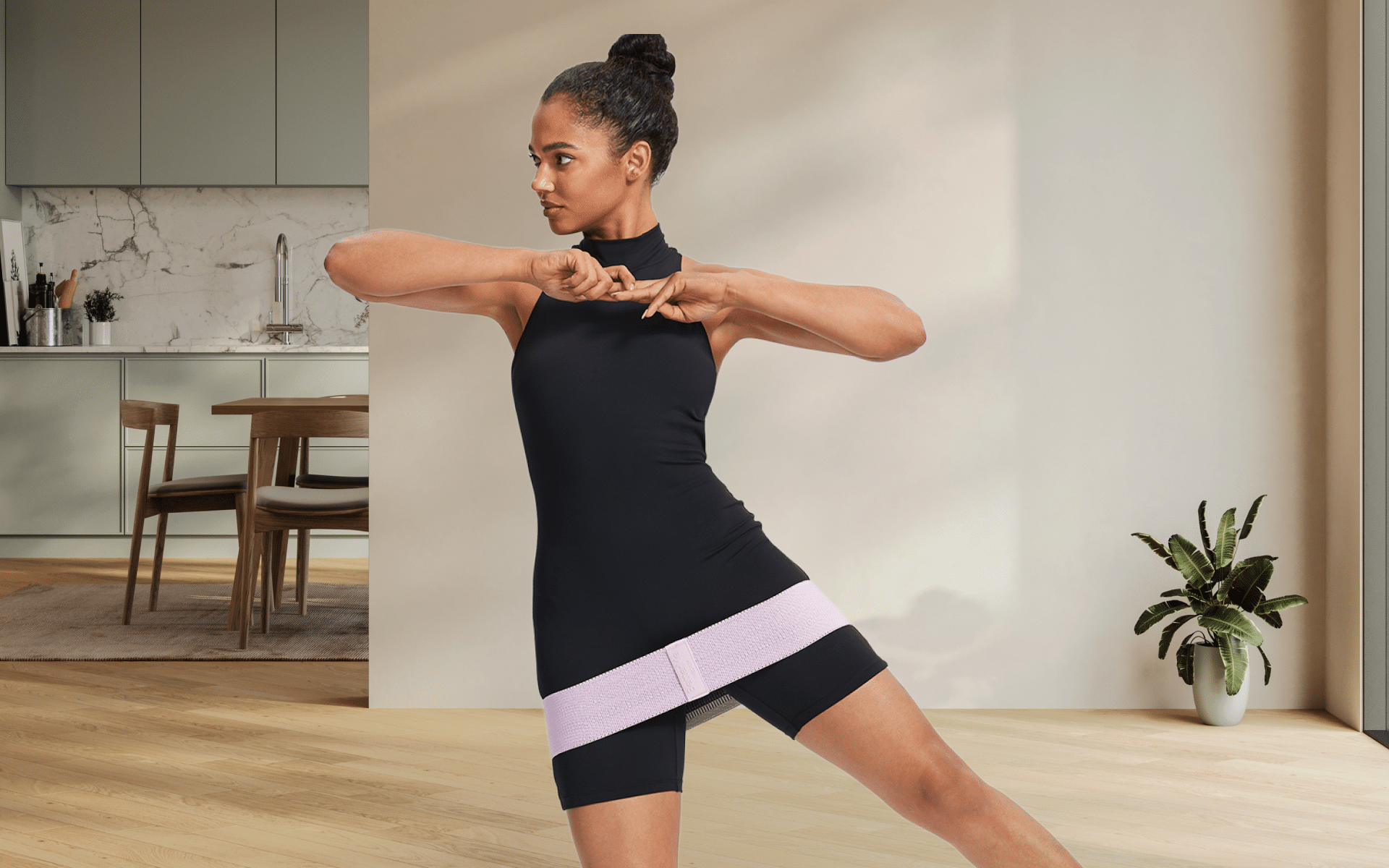
Versatile for Different Purposes
Mini bands can be used for a variety of purposes, including:
- Strength training – By adding resistance to bodyweight exercises, mini bands can help you build muscle and increase strength.
- Physical therapy – Mini bands can be used for rehabilitation purposes, helping improve range of motion and muscle activation.
- Injury prevention – By strengthening smaller muscles and improving overall stability, mini bands can help prevent injury during workouts or daily activities.
- Muscle activation – Mini bands can specifically target and activate muscles, helping improve muscle imbalances and overall muscle recruitment.
- Dynamic warm-up – Adding mini band exercises to your warm-up routine can help activate and prepare muscles for more challenging workouts.
Affordable and Portable
Mini bands are relatively inexpensive compared to other gym equipment, making them a budget-friendly option for those looking to add resistance training to their workout routine.
They are also lightweight and compact, so you can easily pack them in your bag when traveling or going to the gym.
Suitable for All Fitness Levels
Whether you’re a beginner or an advanced athlete, mini bands can provide an effective workout. By choosing a band with the appropriate resistance level, you can tailor your workout to your fitness level and gradually increase the difficulty as you progress.
For example, a mini resistance band workout for beginners may include basic exercises such as clamshells, banded bridges, and monster walks. As you become more advanced, you can incorporate more challenging movements like banded squats and deadlifts.
Read more: Thigh Workout Guide: 7 Effective Exercises for Building Leg Strength
12 Mini Resistance Band Exercises to Get You Started
Use the following 12 exercises to get started with mini resistance bands and target various muscle groups:
Clamshells
Clamshells are a highly effective exercise in any mini resistance band workout for beginners. With a focus on the hips and glutes, particularly the gluteus medius, it is a rockstar for strengthening the sides of your glutes, which are critical for hip stability and knee health.
By wrapping a mini band around your legs, just above your knees, the outward force required to open the legs against the band’s resistance means your muscles must work harder. This increased demand enhances muscle activation, leading to more strength gains.
Steps:
- Lie on your side with hips and knees stacked and bent at a 45-degree angle. Place the band above your knees.
- Keeping your feet together, raise your upper knee as high as you can without shifting your hips or pelvis. You should feel the resistance from the band.
- Pause, then lower your knee to the starting position. That’s one rep.
Banded Bridges
The banded bridge zeros in on the hamstrings, glutes, and core, making it a fundamental part of any full-body mini resistance band workout. Not only does it tone the back of your legs and glutes, but it also activates the core muscles essential for balance and stability.
Placing a mini band just above your knees during a banded bridge forces your knees to push outward against the resistance. This action calls for extra work from your glutes and abductors, improving overall muscle engagement and growth.
Steps:
- Lie on your back with your feet flat on the floor, hip-width apart, and a band above your knees.
- Drive through your heels to lift your hips off the floor, pressing your knees outward against the band.
- Squeeze your glutes at the top, then lower your hips back down. Repeat.
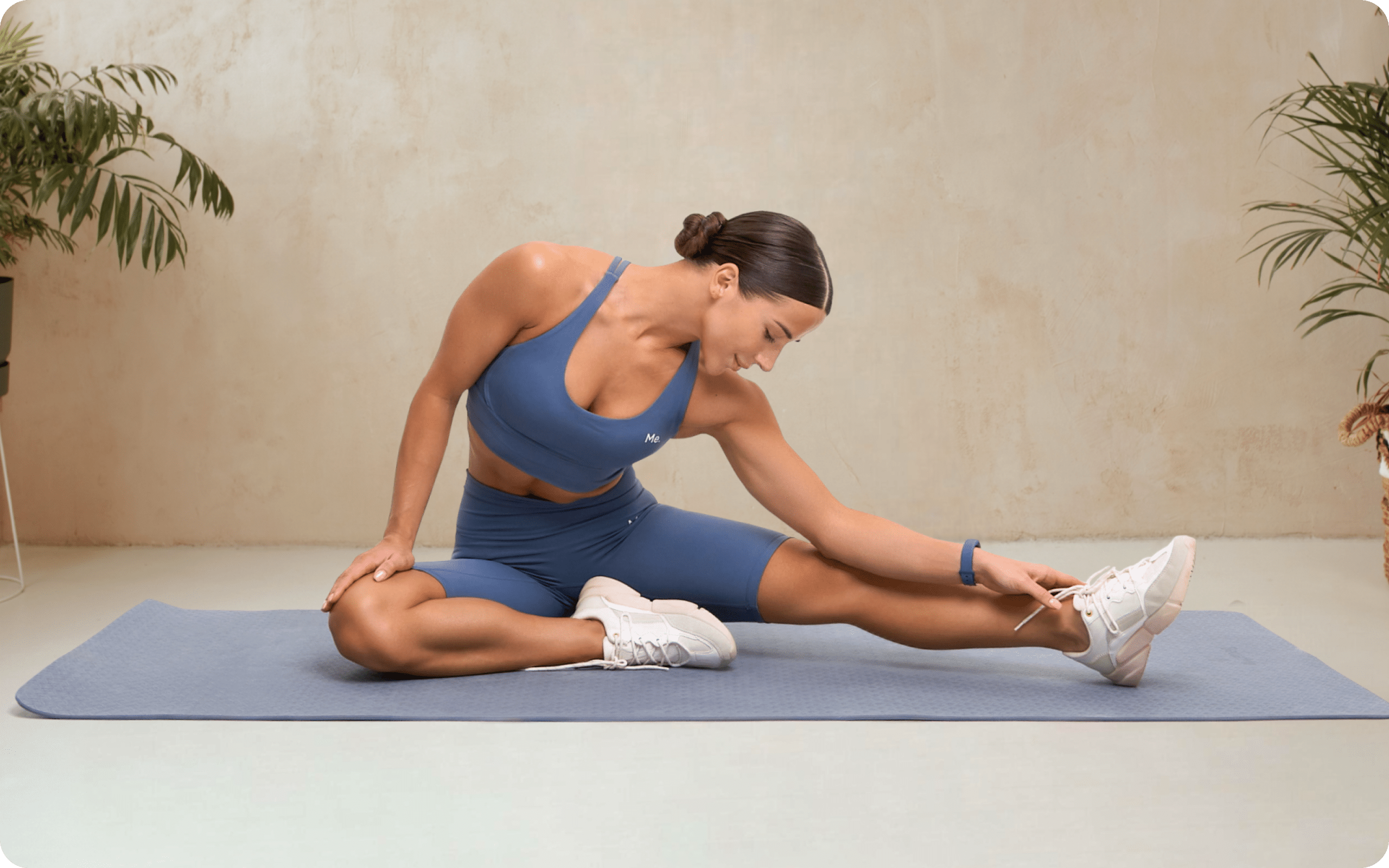
Monster Walks
Monster walks are a dynamic addition to mini band exercises for legs and glutes, as they activate the lower body and help build functional strength. This exercise specifically targets the gluteus medius, which plays an essential role in side-to-side movement stability.
When performing monster walks with a mini band placed around your ankles or feet, the resistance forces your muscles to engage more actively with each step. This engagement is excellent for activating those smaller, often-neglected muscle groups.
Steps:
- Place the band around your ankles and stand with your feet at shoulder width.
- Lower into a half-squat position to activate the leg muscles.
- Step forward and outwards in a diagonal pattern, alternating legs. Continue for 16-20 steps or as per your mini band workout plan for women.
Lateral Band Walks
Lateral band walks are the best mini resistance band workout to target the abductors and the gluteus medius. This exercise is perfect for anyone looking to enhance leg muscle tone, improve hip stability, and boost lower body strength.
Utilizing a mini band for lateral walks adds significant tension to the side-to-side movement. This resistance ensures that your hip abductors are engaged more intensely throughout the exercise, which can translate to visible toning and strengthening over time.
Steps:
- Place a mini band above your knees or around your ankles.
- Adopt a half-squat position to engage your core and legs.
- Step to the side while keeping your toes pointed forward, with tension on the band at all times.
- Take a few steps in one direction, then switch to the other side. Repeat as directed in your mini band exercise routine.
Glute Kickbacks
Glute kickbacks focus on the powerhouse of your posterior chain—the glutes, along with engaging the hamstrings.
By looping a mini band around your ankles or above your knees, the motion of kicking back against the resistance ensures that your glutes are under constant tension throughout the exercise. This added resistance from the band maximizes muscle activation, effectively strengthening and sculpting the backside.
Steps:
- Start in a standing position with the mini band just above your knees or around your ankles.
- Stabilize yourself on one leg, with a slight bend to avoid locking the knee.
- Keeping your core tight, kick the other leg straight back as far as possible, squeezing the glute at the top of the motion.
- Return your leg to the initial position with controlled movement and repeat.
- Perform the desired number of reps, then switch legs.
Standing Single-Leg Tap Out
Standing single-leg tap outs are superb for targeting and activating the lateral hip muscles and the core stabilizers. The mini band, placed either above the knees or around the ankles, enhances the engagement by adding resistance when tapping the foot to the side.
It’s a simple, yet effective way to activate the musculature involved in hip abduction and controlling lateral movements.
Steps:
- Position the band above your knees or around your ankles and stand with feet hip-width apart.
- Shift your weight to your standing leg, keeping a slight bend in the knee.
- Slowly tap the opposite foot out to the side, stretching the band, all while keeping your pelvis stable and facing forward.
- Bring your foot back to the starting position and repeat the motion for several reps before switching sides.
Quadruped Leg Extension
Quadruped leg extensions are excellent for targeting the entire back chain of your body, predominantly your glutes and hamstrings.
With the mini band looped around your feet as you extend one leg back and up, the resistance engages your glutes in particular, ensuring they work hard to perform the movement, which leads to increased strength and muscle tone.
Steps:
- Begin on all fours with the mini band looped around both feet.
- Maintain a neutral spine and engage your core by pulling your belly button towards your spine.
- Keeping one knee on the ground, extend the opposite leg straight back and slightly upward, against the resistance of the band.
- Slowly lower your leg back to the starting position and repeat for the desired number of reps before switching legs.
If you’ve mustered up the courage to crush your weight loss goal, let Betterme take the sting out of this demanding process. Our app will help you restructure your habits, remold your life and crank up your fitness results!
Single Arm Plank Tap Out
The single-arm plank tap out is not just an arm workout; it challenges your core stability and engages multiple muscle groups including your shoulders, chest, and core.
The mini band is placed around the wrists, and as you tap each hand out to the side, it provides resistance that activates the deltoids, pecs, and serratus anterior for improved shoulder stability and core strength.
Steps:
- Assume a high plank position with the mini band around your wrists.
- Set your feet shoulder-width apart to maintain balance.
- Brace your core as if preparing for a punch in the abdomen.
- Tap one hand out to the side while maintaining plank position and resisting the pull of the band.
- Return to center and alternate sides, performing equal reps on each side.

Mini Band Pull Apart
The Mini Band Pull Apart is a phenomenal exercise for targeting the upper back, specifically the rhomboids and the trapezius. It is also beneficial for engaging the rear deltoids, which are crucial for shoulder stability.
Performing this movement with a mini band increases muscular activation, as the band’s resistance requires constant effort throughout the motion, thereby improving muscle engagement and shoulder health.
Steps:
- Grasp the mini band with both hands at shoulder width and extend your arms in front of you at chest level.
- Pull the band apart by moving your hands to the sides and pulling back into a wide row, retracting your shoulder blades as you go.
- Keep the motion controlled as you return to the starting position.
- Repeat for the desired number of reps, maintaining tension on the band throughout the set.
Banded Push-Up
The Banded Push-Up not only engages the pectoral muscles, but with the addition of a mini band, activation extends significantly to the shoulders and triceps, ensuring a full upper-body workout.
The resistance band intensifies all phases of the push-up, which can lead to increased strength and muscle definition over time.
Steps:
- Loop the mini band around your wrists and assume a push-up position. There should be tension in the band.
- Perform a push-up while keeping tension in the band with your arms, lowering your chest to the ground with control.
- Push back up to the starting position, working against the resistance of the band.
- Make sure your body forms a straight line from your head to your heels and you keep your core engaged.
Banded Tricep Pull Downs
Banded Tricep Pull Downs are superb for zeroing in on the tricep muscles. This exercise will also moderately work the forearms and help strengthen the elbow joint.
The mini band’s resistance amplifies muscle activation, creating an efficient way to sculpt and strengthen the triceps without the need for heavy weights.
Steps:
- Secure your mini band to a sturdy overhead object or use your hands to hold one end steady against your opposite shoulder.
- Grasp the band with your other hand, elbow at a 90-degree angle, and your palm facing down.
- Press down to straighten your arm to pull the band down towards your thighs, focusing on moving exclusively at the elbow joint.
- Return to the starting position with control and repeat for the desired number of reps, then switch sides.
Read more: Your Flat Tummy Workouts Just Got Better With This Guide
Banded Arm Curls
Integrating the Mini Band into your arm curls precisely targets the biceps, with supplementary tension on the brachialis and brachioradialis muscles.
Using the band engages the muscle through its full range of motion and increases the time under tension, promoting muscle growth and endurance.
Steps:
- Assume a seated position and loop one end of the band under your foot. Hold in place firmly.
- Hold the other end of the band with one of your hands, palm facing up.
- Curl your hand towards your shoulders by bending at the elbow.
- Slowly lower back to starting position and repeat for the desired number of reps while maintaining resistance on the band, then switch arms.
Check out our Easy Calisthenics Back Workout for some tips on how to incorporate these mini band exercises into your routine for increased back strength and overall fitness.

FAQs
What Are The Disadvantages of Resistance Bands?
The disadvantage of using resistance bands is that they typically only provide a limited amount of resistance, making them less suitable for advanced strength training. They may also wear out quickly and require replacement more frequently than weights.
Can Resistance Bands Help With Muscle Growth?
Yes, resistance bands can be an effective tool for muscle growth by providing constant tension on the muscles throughout each exercise (2). By increasing time under tension and promoting progressive overload, resistance bands can help stimulate muscle growth and increase strength.
Can I Lose Weight By Using Resistance Bands?
Yes, you can lose weight by using resistance bands to build muscle (1). Having a higher muscle mass can increase your metabolism and help you burn more calories throughout the day (3).
Resistance bands can also help burn calories during workouts, leading to weight loss when combined with a healthy diet and regular exercise routine.
How Long Does It Take To See Results from Resistance Bands?
It takes approximately four to eight weeks of consistent resistance band training to see noticeable strength gains and muscle growth. However, results will vary depending on individual fitness levels and how often you incorporate resistance bands into your workout routine.
Keep in mind that a healthy, nutrient-dense diet is also a crucial factor for achieving desired results (4).
The Bottom Line
A mini resistance band can be a handy and versatile tool for a complete body workout. Its compact size makes it perfect for travel or at-home workouts, and its resistance can be adjusted by using different band strengths. They are also an excellent addition to any strength training routine for increasing muscle activation, promoting progressive overload, and ultimately aiding in muscle growth and toning.
DISCLAIMER:
This article is intended for general informational purposes only and does not serve to address individual circumstances. It is not a substitute for professional advice or help and should not be relied on for making any kind of decision-making. Any action taken as a direct or indirect result of the information in this article is entirely at your own risk and is your sole responsibility.
BetterMe, its content staff, and its medical advisors accept no responsibility for inaccuracies, errors, misstatements, inconsistencies, or omissions and specifically disclaim any liability, loss or risk, personal, professional or otherwise, which may be incurred as a consequence, directly or indirectly, of the use and/or application of any content.
You should always seek the advice of your physician or other qualified health provider with any questions you may have regarding a medical condition or your specific situation. Never disregard professional medical advice or delay seeking it because of BetterMe content. If you suspect or think you may have a medical emergency, call your doctor.
SOURCES
- Effects of Different Resistance Exercise Forms on Body Composition and Muscle Strength in Overweight and/or Obese Individuals: A Systematic Review and Meta-Analysis (2022, frontiersin.org) c
- Effects of training with elastic resistance versus conventional resistance on muscular strength: A systematic review and meta-analysis (2019, ncbi.nlm.nih.gov) a
- Increasing muscle mass to improve metabolism (2013, ncbi.nlm.nih.gov) b
- Weight loss – a healthy approach (2022, betterhealth.vic.gov.au) d


